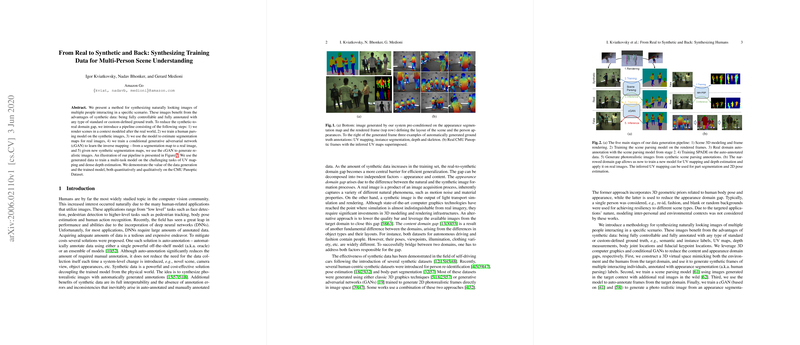An Overview of "From Real to Synthetic and Back: Synthesizing Training Data for Multi-Person Scene Understanding"
The paper presents a comprehensive methodology for leveraging synthetic data to train models for multi-person scene understanding, a fundamental aspect of computer vision. The authors tackle the challenges inherent in creating training datasets through an innovative pipeline that synthesizes realistic images of multiple people interacting within simulated scenes. This approach capitalizes on the benefits of synthetic data—control and full annotation—while mitigating the synthetic-to-real domain gap. The elaborate strategy involves scene rendering, model training, and inverse mapping through a conditional Generative Adversarial Network (cGAN) to produce realistic imagery from synthetic segmentation maps.
Methodology
The paper outlines a multi-step process:
- Scene Rendering: The authors generate synthetic scenes modeled after real-world contexts, carefully constructing 3D environments and populating them with avatars that mirror real human motion and poses.
- Human Parsing Model: A model is trained on synthetic images to perform human parsing, essentially segmenting human figures into meaningful components.
- Real-world Image Segmentation: The trained model is utilized to generate segmentation maps from real-world images, bridging the initial gap between simulated and actual visual data.
- Conditional Generative Adversarial Network: The cGAN learns the inverse mapping, transforming synthetic segmentation maps into realistic images—a crucial step in minimizing the domain gap.
- Photorealistic Image Synthesis: Finally, the cGAN is employed to produce realistic images from new synthetic segmentation maps, facilitating the creation of vast training datasets.
Key Results and Contributions
The efficacy of the proposed method is quantitively demonstrated using the CMU Panoptic Dataset to train and test multi-task models on UV mapping and dense depth estimation. Notably, the authors claim accurate UV mapping using models trained solely on synthetic data—a significant achievement. They propose releasing an extensive dataset, PanoSynth100K, containing 100,000 fully annotated images. The dataset, along with a trained model for generating appearance segmentation labels on real images, promises to be a valuable resource for the research community.
Implications and Future Directions
This research has substantial implications for both practical applications and the theoretical underpinnings of synthetic data usage in computer vision. The demonstrated ability to effectively bridge the domain gap highlights the potential of synthetic data to complement or even replace traditional, labor-intensive annotation processes, especially in dynamic human-centric applications. On the theoretical front, the insights into domain adaptation processes enhance the understanding of how GANs can be utilized beyond straightforward image-to-image translations, emphasizing their role in semantic content preservation.
Future directions may involve refining the level of control over the synthesized output and integrating additional attributes to guide the image generation process. This could entail incorporating more complex semantic labels or designing cGANs that can generalize across even broader target domains without sacrificing realism or fidelity.
In summary, the paper presents a valuable contribution to multi-person scene understanding by employing an innovative synthetic data synthesis technique to address key challenges in the domain. The established pipeline and promising results set a precedent for future work in efficient training dataset creation and domain adaptation.
